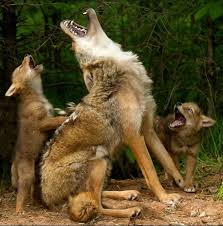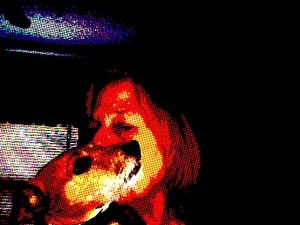The Coyote . . . Wily Cousin of your Domestic Dog
by Barbara K Phillippi

I was lucky to have been “born and bred” in the country, in a very rural area of western New York State. The residents of the hills and mountains that share a border with Pennsylvania are a hearty lot, whose lives are minus many of the comforts and services of a metropolitan area. Instead they choose a harmony with nature. Allegany County, where I formerly resided, has a population of 48,357, a geographic area of 1,034 sq miles, and one department store, a K-Mart.
Looking out from my kitchen windows, I saw wild turkeys, pheasant, quail, deer, and an occasional bear. I visited these old stomping grounds this month, and on a particularly balmy night, after a late supper and evening conversation with a cousin, I took my traveling companion (Gracie, the Jack Russell Terrier) out for “last call.” She froze, and perked her ears toward the wooded hilltops. It was “coyote time.” I was thrilled by the night music, and drifted off to sleep with my window open to the stars, listening to sounds I’ve been missing for a very long time.
Coyotes are members of the dog family, similar in appearance to a medium shepherd. They weigh between 20 and 30 pounds, have pointed ears, a narrow muzzle and bushy tails. The animals exhibit a variety of vocalizations – their scientific name, canis latrans, literally means “barking dog.” This picture, Howling Lessons, is by nature photographer, Debbie DiCarlo. But coyotes don’t really howl, they mostly yip in high pitched notes that sound – well – happy.
Coyotes are not fussy eaters, and will go for fruit, fish, refuse, and mammals large and small – even, on occasion, domestic dogs and cats! In western New York state, coyotes sometimes “take” a new born fawn, calf, or lamb, but there is plenty of smaller game as first choice…rabbits, mice, moles, birds, etc.
The arrival of European settlers in America and their subsequent land conversion eliminated the native wolves, and allowed the coyote to dramatically expand its range. Are there coyotes in Florida? In Palm BeachCounty? Indeed, there are! Here’s a link to scholarly information about the animal and its habitat in Florida, according to the Florida Fish & Wildlife Conservation Commission (FWC).
“The Coyote in Florida”
Compiled by Walter McCown and Brian Scheick
Fish and Wildlife Research Institute
Florida Fish and Wildlife Conservation Commission
June 2007
http://myfwc.com/media/1228800/CoyoteWhitePaperFinal.pdf
Who knew? As recently as March of this year the Town-Crier newspaper reported coyote sightings in Jupiter and Loxahatchee. There are tales of pets being stalked by coyotes, and advice on how to “scare off” a coyote attack, including spraying with a garden hose. Although I’ve lived in coyote country most of my life, I’ve only seen them twice in the daylight. Coyotes can run at speeds of up to 40 miles per hour, and a healthy one is not likely to stick around to be sprayed if it sees you!
An interesting 2009 WPTV report features an interview with Wildlife Director Terry Wolf, who details his experiences with coyotes in the area of his Lion Country Safari attraction. There is no coyote exhibit among the animal exhibits, but it seems that special fencing is needed to keep the wild ones out!
A March 9, 2010 article by Susan Hocking of the Miami Herald, reprinted in the Palm Beach Post, presents a rancher/farmer point of view. It seems also that ranches with “canned hunt” acreage, replete with a multitude of animals, has encouraged the coyote to expand its range to the southernmost Florida counties.
http://www.examiner.com/article/coyote-problems-palm-beach-county
Most everyone is familiar with the cartoon character, “Wile E. Coyote.” The scenes of Wile E. outsmarting his pursuers with stealth, cunning, and an instinctive intelligence, while not realistic, do allude to the coyotes’ keen senses of survival. And remember, next time you take your dog for a walk you have at the end of the leash a cousin of these remarkable canine. They share many of the same genes, and instincts. The coyote is also subject to the same illnesses and conditions as our household pets, including distemper and rabies.
I do hope that many of you will open the links, research and learn more about these truly unique American animals. If one has never heard the voices of coyotes at midnight, or just before dawn, it’s a very special thing, even if experience probably isn’t on everyone’s “bucket list.” Until next time, I’ll renew that childhood wild wish to always have a spirit as free, and natural, as the enigmatic coyote.
“In a perfect world, every dog would have a home, and every home would have a dog.”
Over a lifetime, Barbara Phillippi has had mostly “normal” dogs – a few German Shepherds and a bunch of wonderful “mutts,” each with its own wonderful, quirky, qualities. For many years, she taught 4-H dog obedience courses, under the authorization of Cornell University’s Cooperative Extension Services. That terrific program teaches the basics of dog behavior, of every breed, to young dog owners. Today she lives in Wellington with three Jack Russell Terriers – Woody, Gracie, and Buck. “These guys showed me a learning curve that I never knew existed!”




